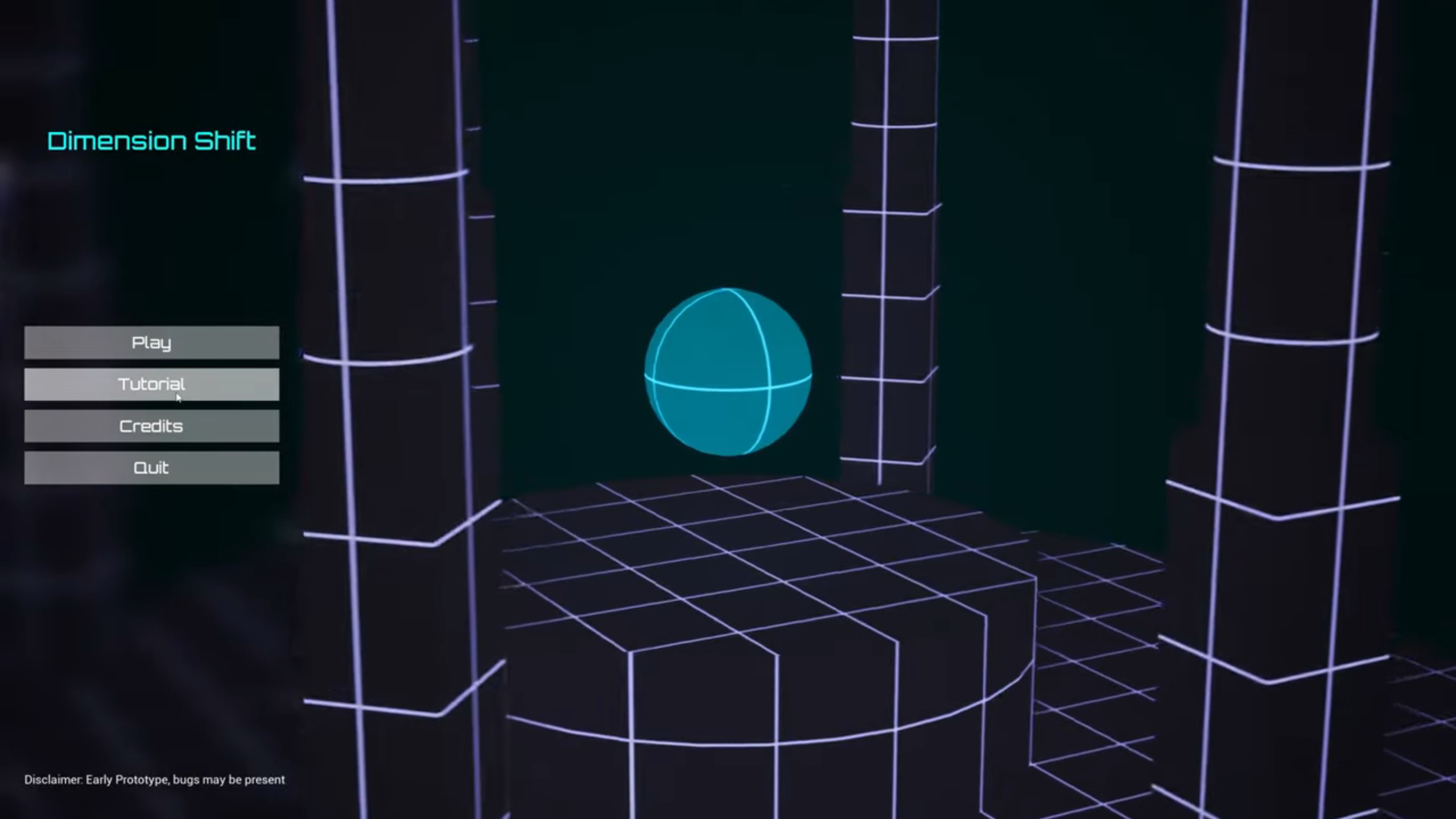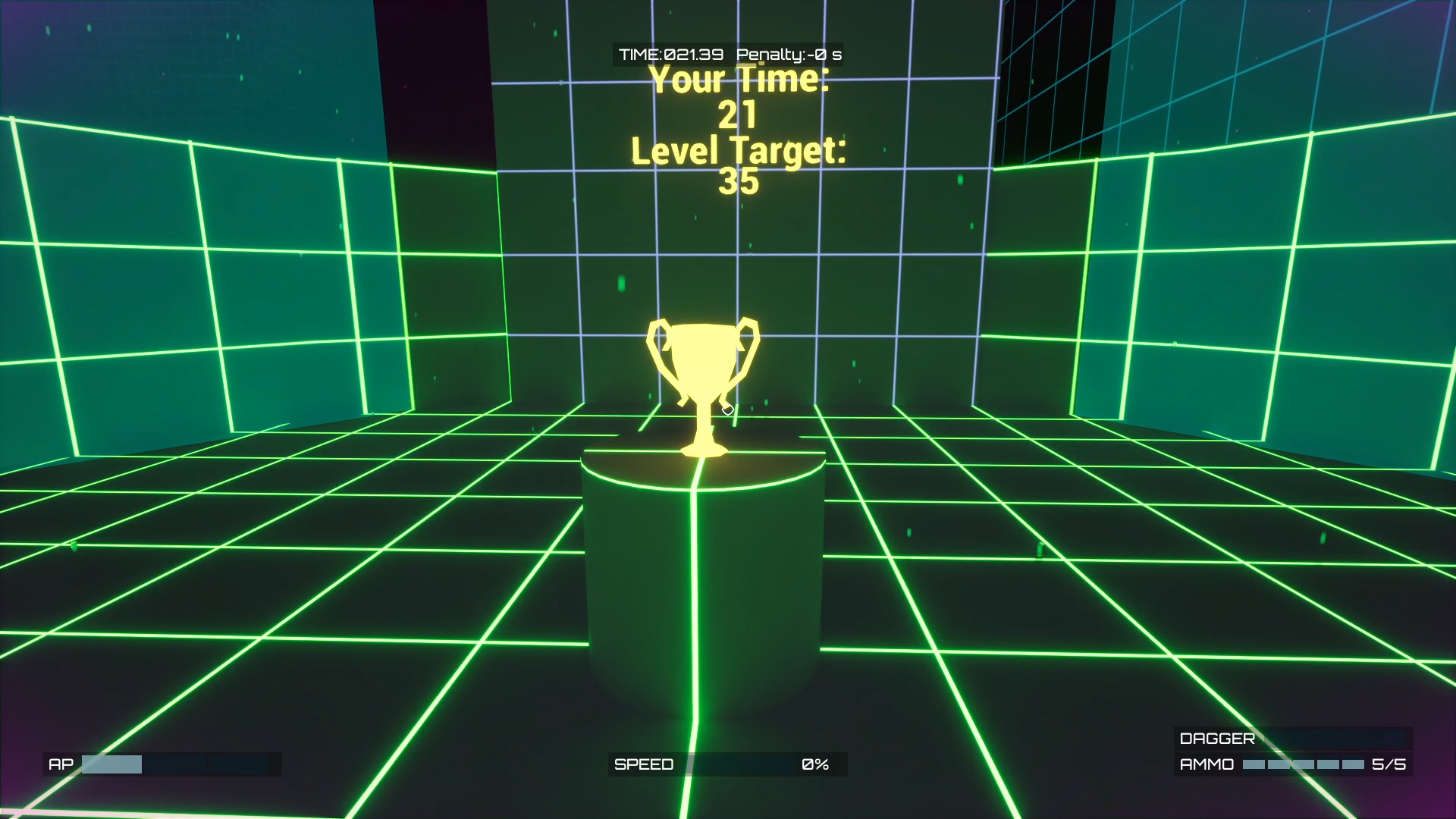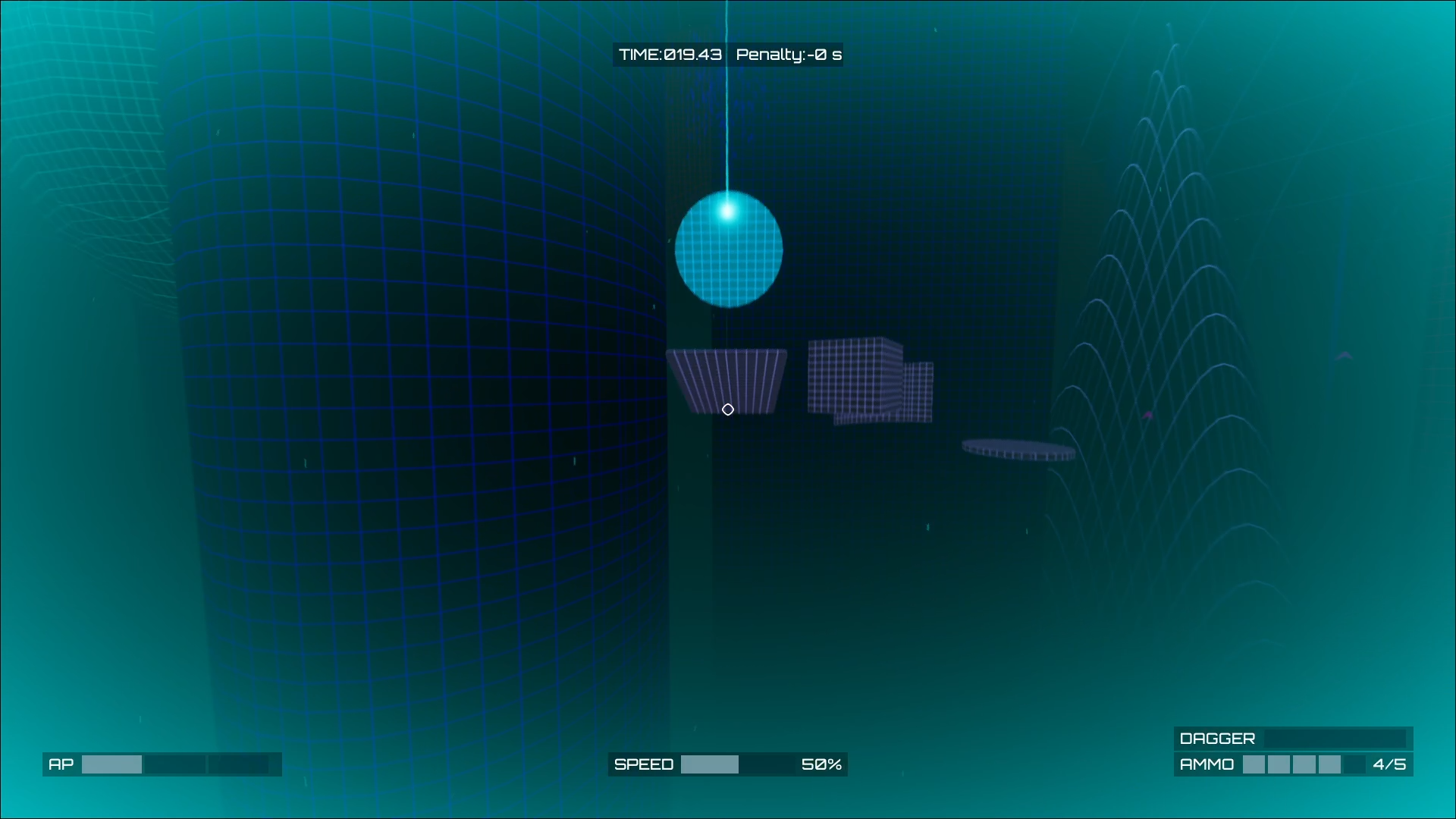Dimension Shift
Fast-Paced 3D Platformer – UE5
Intro
This game was made as a game jam with another friend. Below you’ll see an analysis of the game’s mechanics and the thought process that went into its design, then further below a post-mortem of what could be improved if I were to revisit it.
The game’s goal is to reach the end of the level as quickly as possible with minimal deaths.
The player has access to an array of movement mechanics, as well as the ability to “shift” between two alternate dimensions, allowing them to pass through some objects or remove some obstacles before having to cross them.
Before diving in, have a look at some gameplay in the video below!
Overview
I worked on this project with another friend. I was more of a generalist Game Designer during the project, working on the Gameplay, 3C, Level and UI aspects, while he focused on Technical Design, also being the primary programmer for the project.
Core Pillars
From the beginning, we aimed to establish three core pillars to the game. Those were:
Mastery – the game rewards the player for having the best time, while throwing increasingly complex level scenarios at them.
Discovery – we intentionally designed certain level sequences to allow multiple ways of overcoming an obstacle by making use of the various abilities.
Sensation – we wanted to induce cognitive immersion and a state of flow by syncing the player’s actions with the music.
Movement System
We spent a lot of time nailing down the core movement of the game, playing with the parameters until it felt right to us.
The movement system features an acceleration mechanic, allowing the player to gain more and more momentum if they make as little contact with surfaces as possible, rewarding masterful play while at the same time enforcing the Mastery Core Pillar.
We also added a system that would increase the FOV proportional to how fast the player was going, enforcing the Sensation Pillar.
The running slide was added to provide another option for players to use to get over obstacles – with the added bonus of feeling really cool to pull off – which enhances Discovery and Sensation.
The Abilities
While it may seem like we went overboard with the amount of options we gave players, it was a deliberate choice, in order to enforce the Discovery Pillar.
Dimension Shift – the defining mechanic of the game, requiring good planning, fast reflexes and encouraging the player to explore. The plan was to eventually allow the player to discover secret pathways or little collectibles.
Projectiles – this is the player’s primary way of interacting with the world, a 3-dimensional click, if you will. We wanted this to be a check of the player’s aiming prowess, as well as a way for them to destroy obstacles. Players can only use the projectiles while in midair (something I would change now, looking back at it – more in the post-mortem below). Players can also aim while in midair, slowing down time, but consuming all projectiles in the process. The idea behind this part was to give more time for players to take particularly difficult shots, while also being useful for destroying stacked obstacles.
Action Points – the main resource that the player needs to keep track of. The game gives the player a set amount by default, which is always reset when the player touches the ground, therefore allowing the player to choose how they spend these actions while in the air.
Air Boost – a classic and a must-have in any movement-based game, the Air Boost is like a double jump – except the player can use it as many times as they want, provided they have enough Action Points.
Air Dash – the horizontal counterpart to the Air Boost, this ability allows the player to quickly traverse a horizontal distance, with the caveat that it does not not increase their acceleration – therefore not being exploitable for increasing acceleration instead of its intended purpose.
Wall Run – a new way for the player to refund their action points – and a stylish way to traverse levels!
Blink Dagger – inspired in part by Final Fantasy XV’s Warp mechanic, we thought: “what if you could do that, but in a movement shooter?”. This mechanic allows the player to “save” a location they want to be able to return to while executing their parkour, as well as allowing them to get through narrow gaps that the other mechanics would not normally allow.
The Levels
We knew that the amount of mechanics was a bit overwhelming to new players, so clearly pacing is an important aspect of this. However, since this was meant to be a game jam, we wanted to showcase as many of the abilities as possible in the demo.
When designing the levels, I used a Kishotenketsu approach, which is normally used as a narrative structure by Japanese, Korean and Chinese writers, but it’s also used as a level design principle by Japanese developers, such as Nintendo with the 3D Super Mario games.
The concept is as follows: introduce the mechanic in a safe environment, then test the player’s prowess in an unsafe environment, then add a twist to it by introducing a new way to use the mechanic, and then finally add a tough challenge that makes use of everything that the player has learned.
The levels feature a couple of interactables: action point pickups and action point targets. They refund action points to players on contact and on hit respectively, allowing them to execute more complex maneuvers without having to touch the ground.




Post-Mortem: What could be better
While I will not be further working on this project in the near future, there are quite a few changes that I would like to make to it.
1. The Shooting
As expressed above, the shooting is an important aspect of the player’s interaction with the world.
The first change would be to allow players to shoot at any time, not only while in midair, because it can be restrictive. The problems that this could create would be to drastically simplify the segments that were meant to make the player shoot while in midair, therefore decreasing the mastery aspect. This can be fixed by reducing the range of the bullets and making adjustments to the level design to make it harder for players to abuse it from the ground.
I would make the shootable targets more fun and satisfying to interact with by spending more time finetuning the feedback mechanism, which ties into realization as well (therefore also supporting the Sensation pillar)
I would also add more physics-bound objects scattered around the map, which would make the world feel more organic and less artificial.
2. Improved Feedback Mechanisms
Much more care needs to go into showing the state of the various objects in the world, since the player needs to be able to tell, at a glance, whether they are interactable in one dimension or the other, whether they are destroyable or not, or whether they are a danger or not.
3. Less UI
While the current implementation of the UI does show my technical prowess with UMG, it was a suitable solution considering the limited time we wanted to spend on the project
However, sometimes less is more. For example, for the dagger, we could add the dagger itself a floating companion in one of the corners of the screen, which easily translates its three states: deployed/not deployed/on cooldown. The latter would be depicted by a lack of VFX surrounding the dagger.
I would also rework the speed indicator. Its use was for advanced players to gauge whether they can make certain jumps depending on their speed at the time. A more elegant solution with less cognitive load would be to remove the percentages – or perhaps the whole bar – and replace it with 2 or 3 thresholds of speed, which could be shown via more simplistic UI elements, some kind of camera effects or perhaps via sound. This way the player knows when they’re at the right threshold for a specific jump, provided that the levels will be designed so that any speed in its respective threshold is sufficient to surpass that obstacle.
4. Better Level Pacing
While the levels were made as a demo, a finished product would slowly introduce the players to the various mechanics one at a time, giving them much more time to familiarize with them before moving to the next one. The tutorial would be split into multiple smaller chunks, only explaining what’s needed, when it’s needed.
5. Realization
This means better animations, better vfx, more care into sound effects and more ways for the environment to respond to the player’s actions, similar to how games like Hi-Fi Rush have environment elements that pulsate to the beat of the song, which makes it easier for players to get immersed and reach flow (supporting the Sensation Pillar as well).
I count narrative to be a part of realization, as to offer players an additional reason to want to complete the challenges and to want to Discover what happens next. I would also tie secret narrative bits to the Mastery aspect by only unlocking these additional bits if the player completes it within a certain time, or by earning all collectibles in one run.